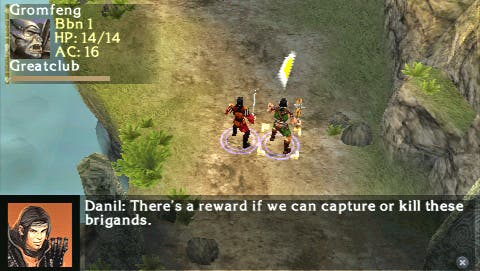Dungeons and Dragons Tactics
Another gem? Or plumbing new depths?
Whether you're one of those people who sneer at orcs and goblins, and scoff at bearded men who roll dice, or whether you're actually one of those bearded men (or, indeed, women), it's impossible to deny the far-reaching influence of Dungeons and Dragons. Without Dungeons and Dragons we'd still be stuck playing Space Invaders. We wouldn't be playing Zelda, or Final Fantasy, or Dragon Quest, or maybe even Deus Ex. We may not even have been introduced to Doom. And we certainly wouldn't have been able to play any of the magnificent officially licensed D&D videogames, from SSI's gold box series all the way up to Bioware's richly detailed narrative epics. And now, hopefully, up to Dungeons and Dragons Tactics, a turn-based strategy title for the PSP, created by Kuju Entertainment.
The latest licensed D&D title is a faithful recreation of the D&D 3.5 edition ruleset, which is, in many ways, a good thing. The 3.5 edition rules are the culmination of over 30 years of playtesting, and they've been ripped off so many times that the basics will feel instantly familiar even if you're one of those people who laugh and point at people who play with dice. Conveniently, the 3.5 ruleset is also well suited to a turn-based strategy game, because, it is, essentially, a turn-based strategy game. The way it works on the PSP is ultimately the same way it works around a table: every turn, characters get a chance to move and a chance to perform a standard action, like attacking, or moving again, or quaffing a potion, or whatever. And so do the enemies.

At the start of the game you get to pick one of 26 predefined characters as your player character, and then another five as their party members. Or you can create your own characters, exactly as you would in the pen and paper game, picking from all of the major races and classes. After that, the game is divided across a campaign screen, where you can move to new locations and visit shops and temples, and a 3D isometric view adventure screen when you decide to do some dungeoneering. And that's when the action really starts, as you guide your characters across a movement grid divided into squares, hunting for treasure, and engaging any enemies in combat by hurling missiles, spells, psionics and melee attacks at them.
But the fact that the game is a faithful recreation of the 3.5 edition D&D rules is also a slightly bad thing, because the 3.5 edition rules can be pretty unforgiving at the outset. The first few adventures in the game are little more than a warm-up, in which you take only one or two party members out to hunt a handful of goblins. It's a good way of allowing players to familiarise themselves with the rules and interface before moving on to more demanding dungeons, but they'll spend most of their time failing to hit anything.
Another bad thing is that there are plenty of more worrying niggles, and since the game is already out in the US, they're unlikely to be fixed by the time the game comes out over here. One such niggle is that there is very little feedback during combat, and very little support for D&D novices. The game doesn't make it very obvious when one of your characters is dying, for example, or even, for those unfamiliar with the rules, what that means in terms of the game mechanics. Simple things, like the fact that skeletons take half damage from non-blunt weapons, or that the undead are resistant to mind control spells or psionics, could be made much clearer at the start of the game.

A much worse bad thing is the idiosyncratic interface, which requires multiple menu navigation to do the simplest things. Inventory is especially difficult to manage, whether it's buying and selling items on the campaign screen, or trying to loot treasure chests during adventures. Whether you're trying to figure out the weight of items or your character's carrying capacity, you'll have to click through umpteen different screens to work out whether your character will end up encumbered (and consequently less mobile). Likewise, trying to match items to the skills required to use them is a Byzantine navigatory nightmare. It's not even clear how to swap items between party members during adventures.
These are pretty significant flaws, and exploring the actual dungeon is just as cumbersome - because there's no easily accessible map of the area, and because it takes ages moving each character individually, even when there's no threat. That's worrying because in the history of officially licensed D&D videogames there's an absolute stinker for every masterpiece. If Dungeons and Dragons Tactics is to become another Baldur's Gate, or Dark Sun, these flaws will need to be fixed. If they're not, it'll just be another Temple of Elemental Evil. Which, for the benefit of non-D&D fans, means it'll be rubbish.
